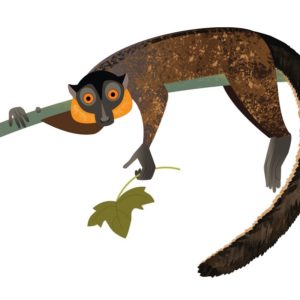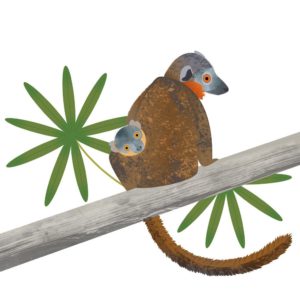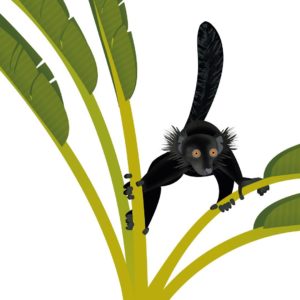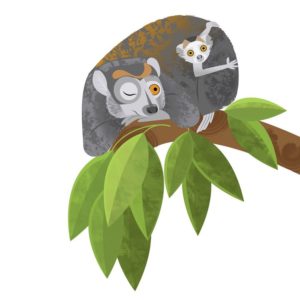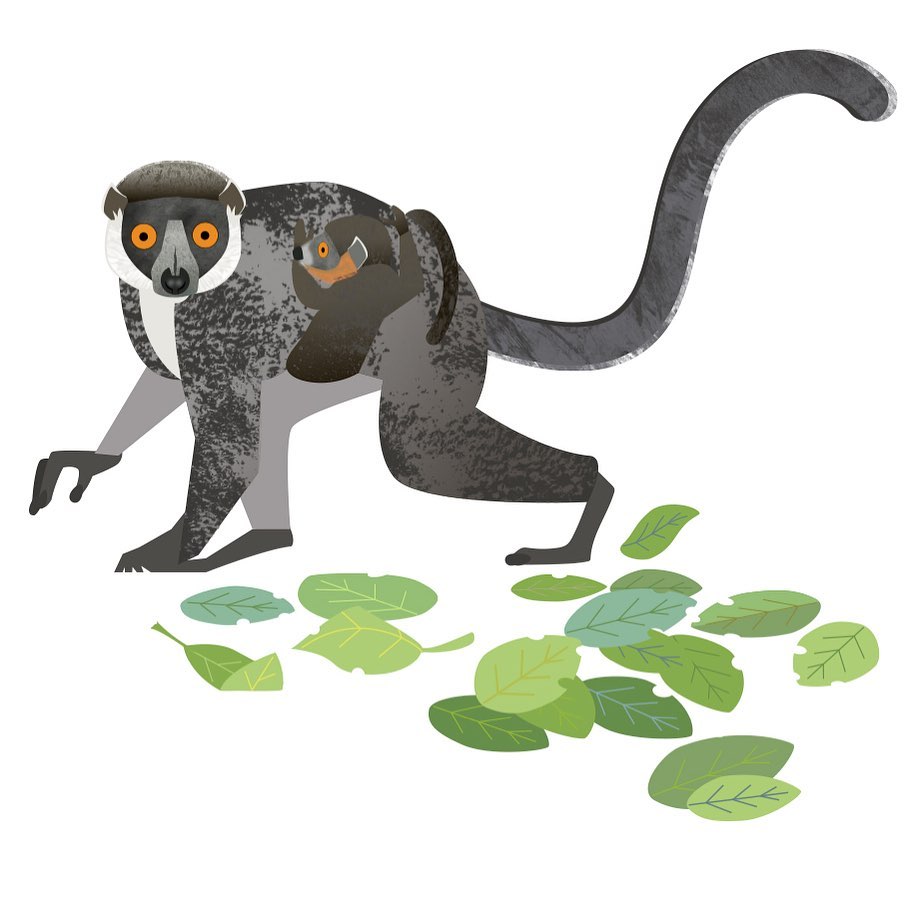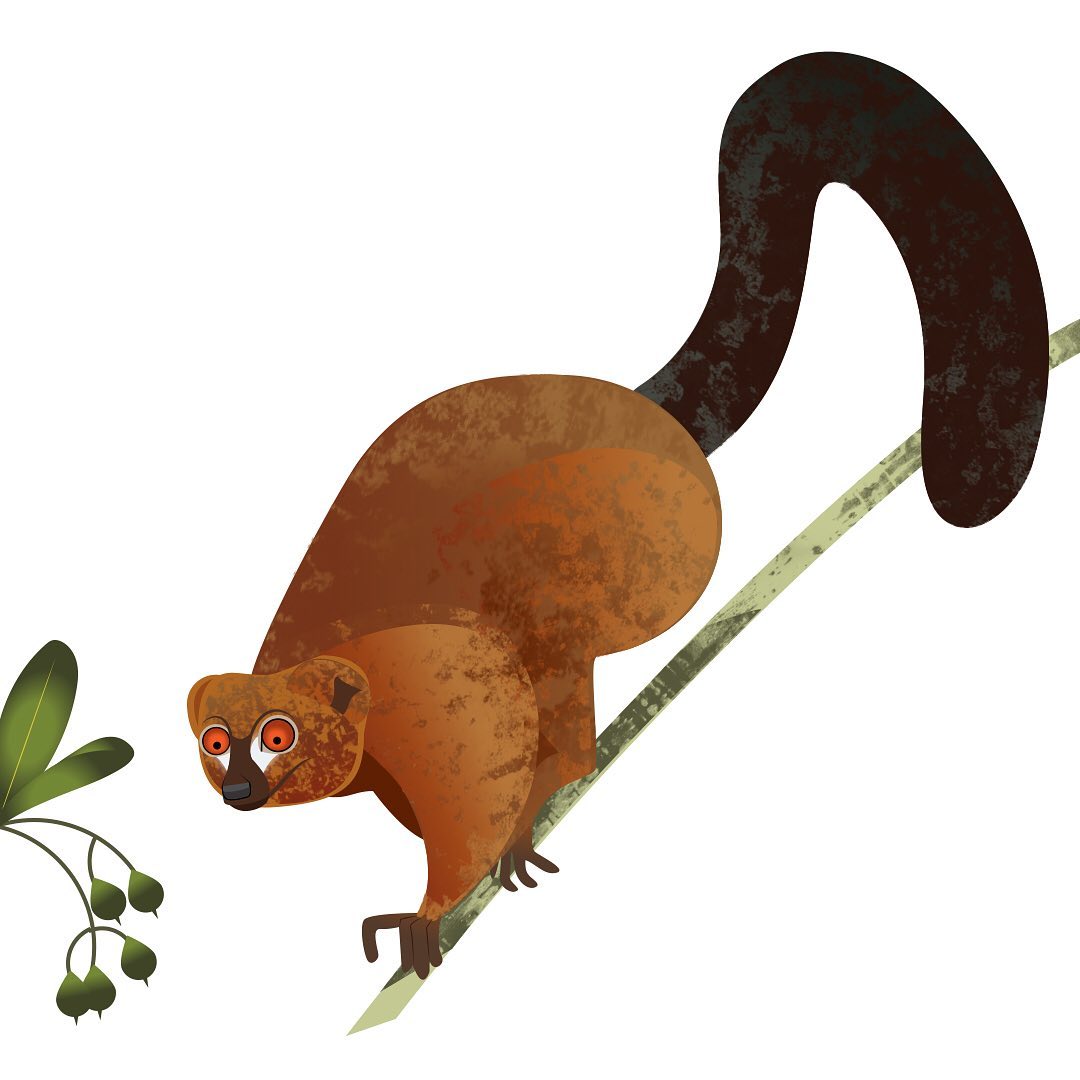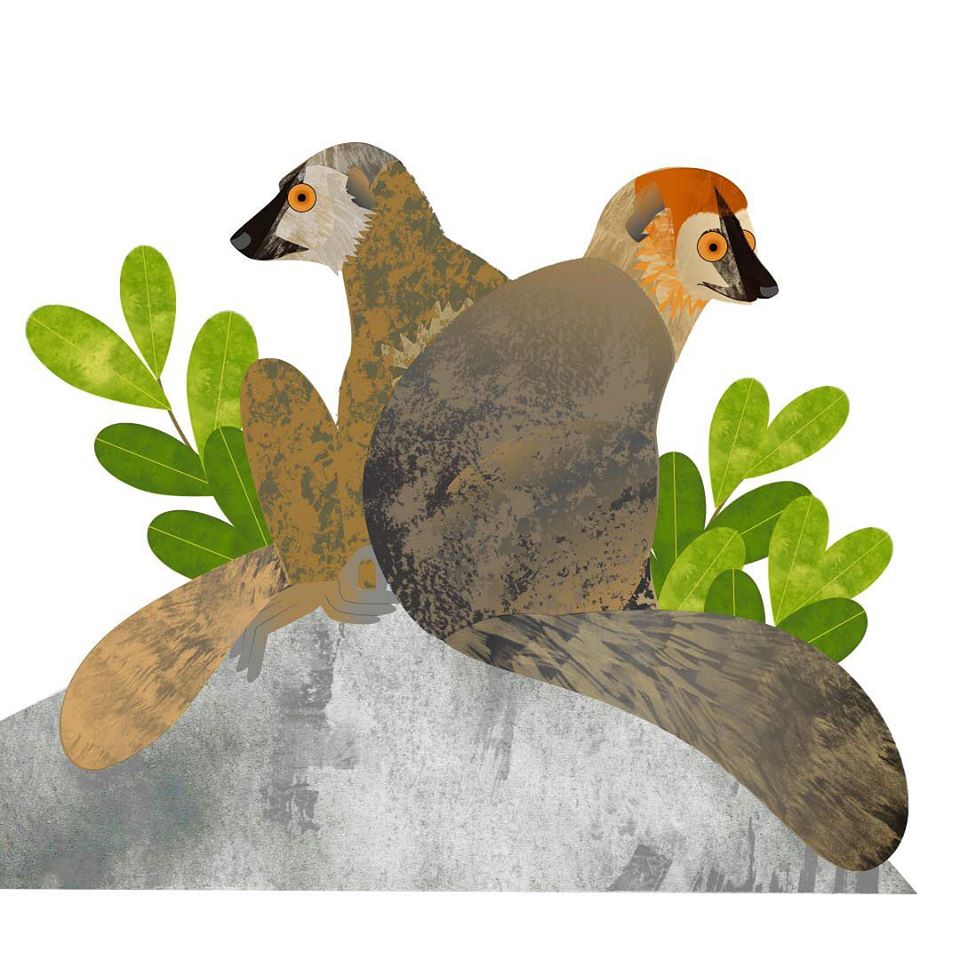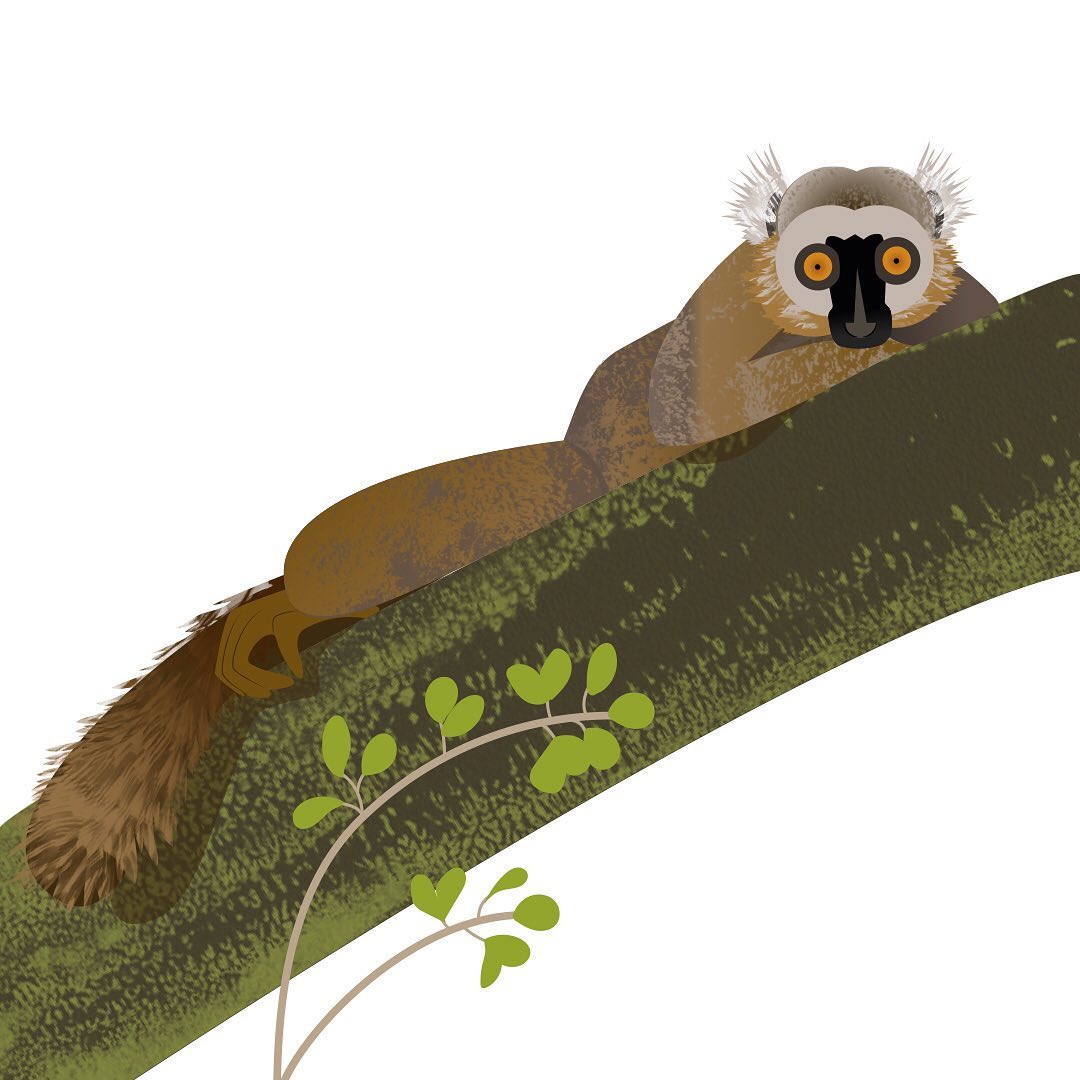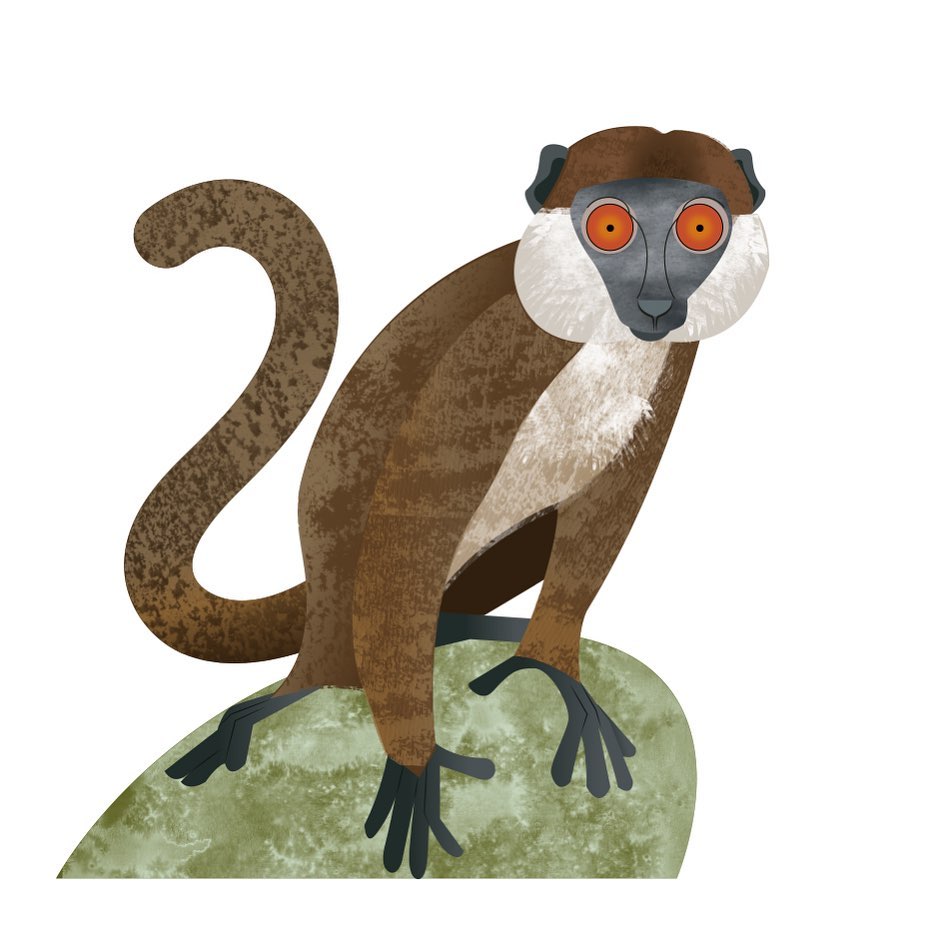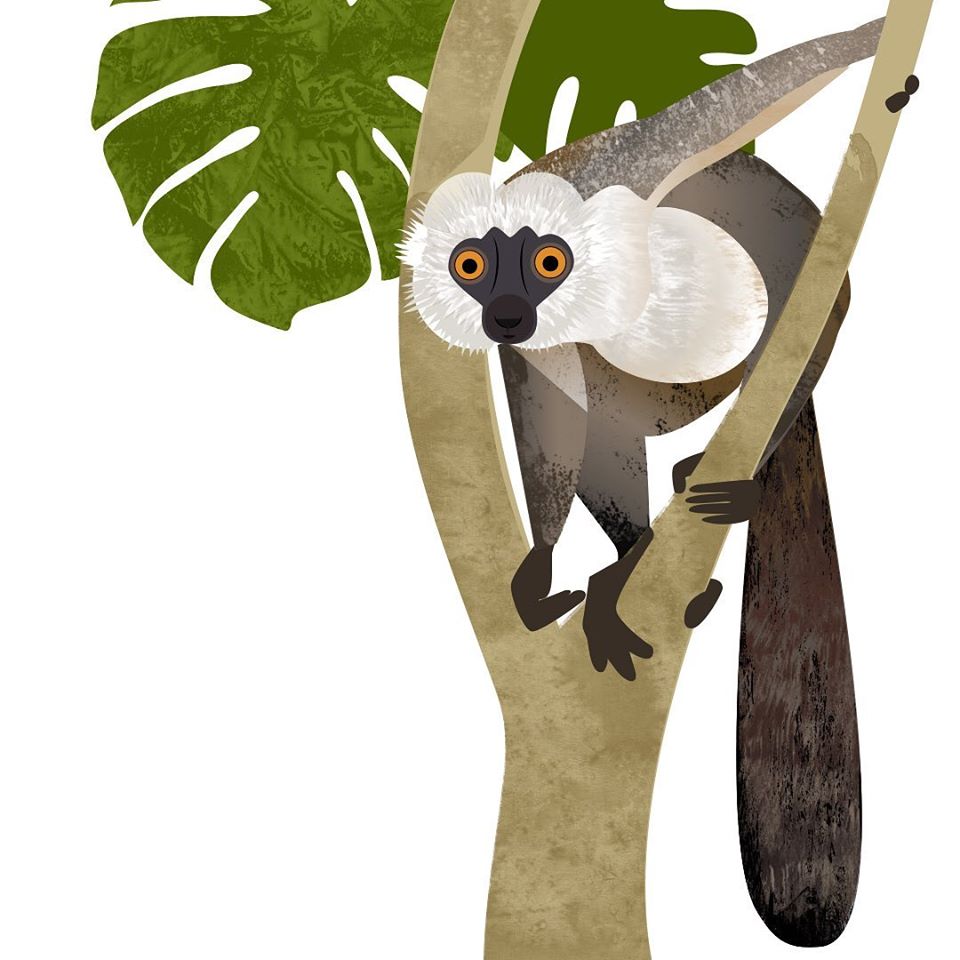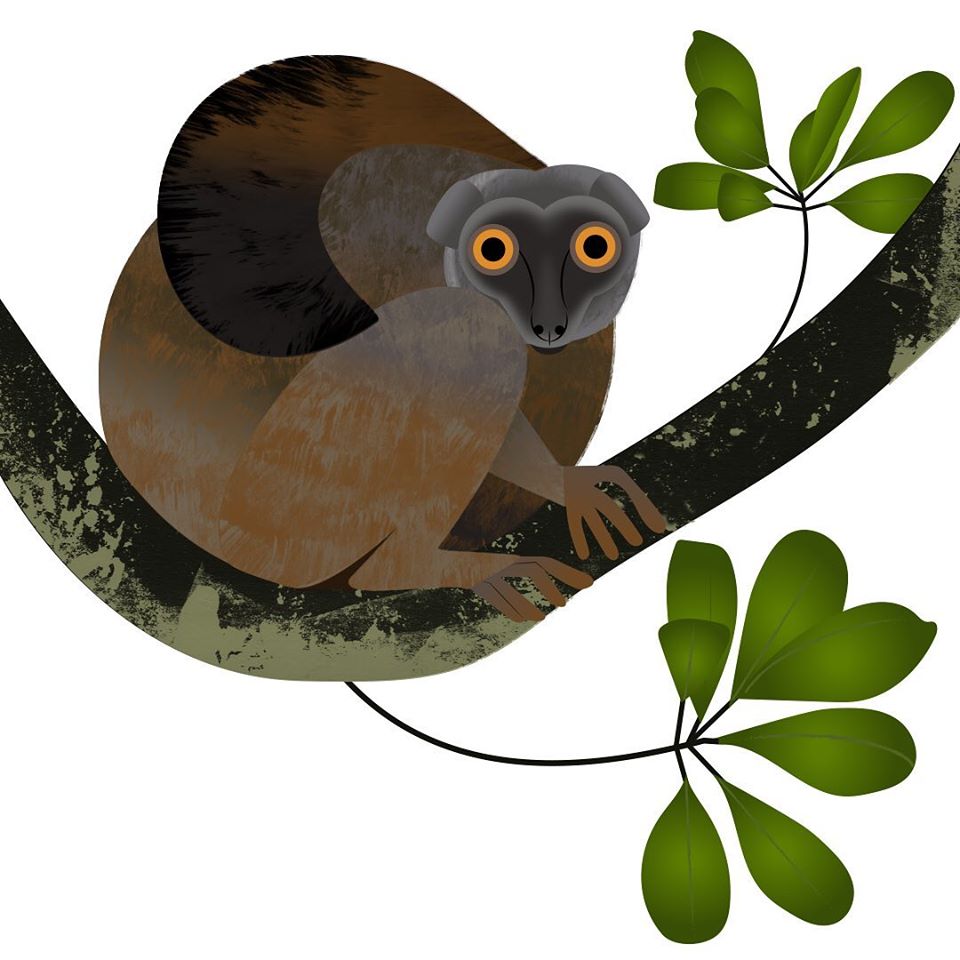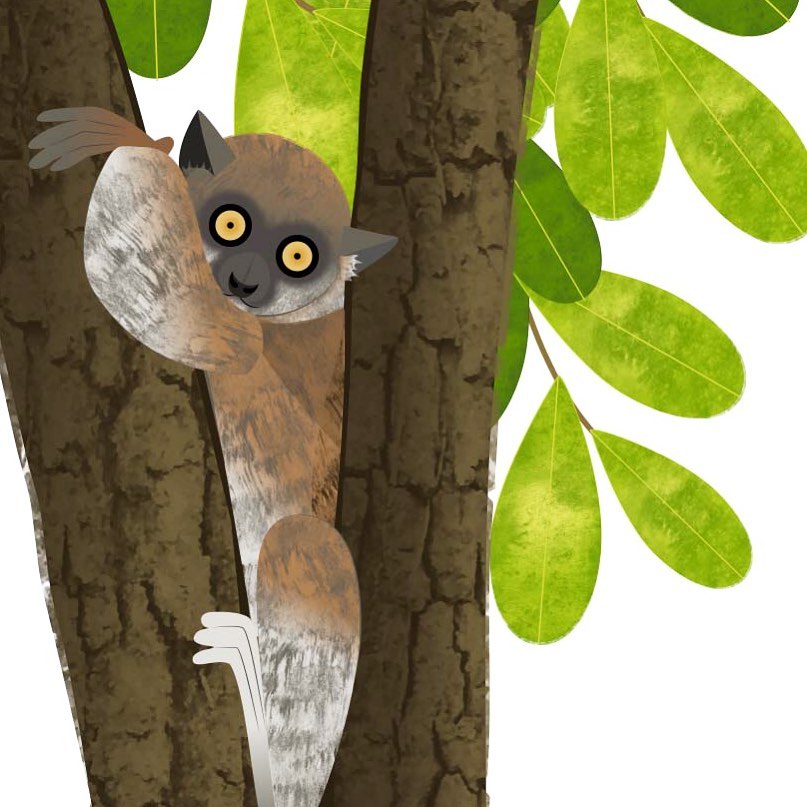Welcome!
Welcome to page two of 100 LEMURS, an international collaboration between the Duke Lemur Center, a world leader in the study, care, and conservation of lemurs, and Rachel Hudson, an award-winning wildlife illustrator based in the UK!
To return to page one and to view our first 14 featured species, please click here.
Day fifteen
Check out this handsome male red-collared brown lemur (Eulemur collaris), one of 11 species of brown lemur categorized under the genus Eulemur!
Unlike most lemur species, collared lemurs are not female-dominant and display no clear dominance hierarchy.
Like the blue-eyed black lemurs featured in Days Thirteen and Fourteen, collared lemurs are sexually dichromatic, meaning that males and females have different coloration patterns. Males (pictured here) have a larger, bushier “beard” compared to the females. Their beard is also more of a reddish-cream color whereas the females’ beards are darker in color.
Collared lemurs look similar to the white-collared lemur, but can be distinguished by their slightly darker beards.
Six collared lemurs live at the DLC. To learn more about these endangered lemurs, please visit our collared lemur species homepage.
Day sixteen
Look at this female red-collared brown lemur (Eulemur collaris) with her tiny peekaboo baby! Collared lemurs are sexually dichromatic, which means that females have different coloration patterns compared to the males of their species.
Compared to males, female collared lemurs have a darker, less bushy “beard” – which also looks like an orange collar, hence these lemurs’ name.
Collared lemurs are classified as endangered and live in the southeast rainforests of Madagascar.
At the DLC, collared lemurs are given French-themed names. Our most recent collared lemur birth was little Celine, born to first-time mom Bijou!
Day seventeen
Meet the male common black lemur (Eulemur macaco)! Common black lemurs live in northwestern Madagascar in primary and secondary humid forests, and are currently classified as a vulnerable species.
They’re cathemeral, meaning they will forage for food both during the day and at night.
These bewhiskered black lemurs are important pollinators for the Parkia genus of trees, whose flowers only bloom at night. They are also the sole seed dispersers for several plant species, and are one of the main pollinators for the iconic traveller’s palm.
This species used to be housed at the Duke Lemur Center, where individuals were named after Greek gods and mythological figures.
Day eighteen
In Madagascar, common black lemurs (Eulemur macaco) — like this female pictured here — will gently bite toxic millipedes to provoke them into releasing their toxins. The lemurs will then rub the millipedes all over their fur. The toxins produced by the millipedes are insect repellent!
Common black lemurs are sexually dichromatic. Males have black ear tufts and rich black fur covering their entire bodies. Females have white ear tufts and brownish-orange fur.
Infants are born with their mother’s coloration. Male infants will gradually shed out and grow in adult male coloration patterns, starting at about 5-6 weeks of age.
Day nineteen
Lemurs have long wet noses and a keen sense of smell, and scent is an important means of communication! A male crowned lemur (Eulemur coronatus, pictured here) has a variety of scent-marking methods, one of which involves vigorously rubbing the top of his head, where a scent gland is located, onto a suitable marking surface.
Some efforts, such as courting a female, involve so much scent-marking that occasionally the male will develop a small, temporary bald patch on his forehead!
13 crowned lemurs live at the DLC! If you’d like to learn more, please visit our crowned lemur species homepage. You can even symbolically adopt a crowned lemur through our Adopt a Lemur program!
Day twenty
Look at this gorgeous female crowned lemur and her adorable infant! Crowned lemurs (Eulemur coronatus) are named after the males’ vivid black and orange “crowns” on their foreheads. Whereas males’ fur is a rich chestnut brown, females’ fur is soft gray with a light orange “tiara” on the forehead.
Crowned lemurs are endangered due to habitat loss, including deforestation caused by sapphire mining. (According to the president of the Natural Sapphire Company, Michael Arnstein, Madagascar produces about half of the world’s high-end sapphires.)
How can you help? Before purchasing a sapphire, ask where your stone was mined and buy only from jewelers who are committed to ethical sourcing. Or consider heirloom or antique stones: vintage jewels can be reset to make a modern necklace or ring, and don’t perpetuate current illegal mining operations.
If you’d like to learn more about crowned lemurs while supporting their care at the DLC and their conservation in Madagascar, please consider symbolically adopting Sanura, a female crowned lemur, through our Adopt a Lemur Program!
Day twenty-one
What’s in a name? Don’t be fooled: This male mongoose lemur (Eulemur mongoz) is not related to mongooses! Instead, this lemur species probably gets its name from its supposed similarity – at least superficially – to the mongoose. Both animals have small ears, pointy noses, long tails, and grizzled fur.
Unlike the carnivorous mongoose, however, the mongoose lemur is a gentle primate that feeds on fruit, flowers, nectar, and leaves. Males, like the one pictured here, have vivid orange chins whereas females’ chins are snowy white.
Sadly, the mongoose lemur is critically endangered in Madagascar due to habitat loss and bushmeat hunting. 10 mongoose lemurs live at the DLC as part of our conservation breeding program. If you’d like to learn more about these very special, very endangered lemurs, please visit our mongoose lemur species homepage.
Day twenty-two
Critically endangered mongoose lemurs, like this female mongoose lemur and her infant, live in the dry deciduous forests of northwestern Madagascar.
They live in small family groups generally consisting of a strongly bonded adult male (distinguished by his orange cheeks and chin) and female (white cheeks and chin), plus 1-3 of their immature offspring.
Like most lemurs (the aye-aye is a notable exception), mongoose lemurs’ bottom teeth form a special toothcomb, which they use for grooming themselves and other lemurs within the family group. Social grooming is not only hygienic but also strengthens the social bonds within the group.
10 mongoose lemurs live at the DLC as part of our conservation breeding program.
If you’d like to learn more about these critically endangered lemurs, please visit our mongoose lemur species homepage.
Day twenty-three
The red-bellied lemur (Eulemur rubriventer) has a big geographic range throughout many rainforests in eastern Madagascar.
Both males and females have rich, fluffy coats of reddish to chestnut brown; however, females have a characteristic white belly, whereas males have characteristic white teardrops in the corners of their eyes. Males also have a pronounced scent gland atop their heads, making them look like they slathered on too much hair gel.
A monogamous species, red-bellied lemurs can often be seen in small family units or social groups comprising mom, dad, and their offspring.
These lemurs are important to Malagasy ecosystems: They can swallow and excrete, and thus disperse, relatively large seeds.
The DLC houses one red-bellied lemur, Cheyenne, who turned 32 years old on April 21! Happy birthday, Cheyenne!
Days twenty-four and twenty-five
Meet the red-fronted lemurs (Eulemur rufifrons; female on the left, male on the right)!
At first, these lemurs were called Eulemur fulvus rufus. They were considered a subspecies of the common brown lemur and were grouped with the other type of red lemurs. Then in 2001, red lemurs got their own species status (E. rufus), and in 2008, mounting genetic and morphological evidence split this species into the two we know today: red lemurs (E. rufus) and red-fronted lemurs (E. rufifrons).
Red-fronted lemurs are one of the rare lemur species that inhabits rainforests like Ranomafana National park in the east and dry forests like the Kirindy forest in the west. In the west, the famous Tsiribihina river provides a geographical boundary that separates them from the red lemurs (Eulemur rufus) who live on the other side of the bank, a bit further north.
Like their closest relatives within the brown lemur group, red-fronted lemurs are unusual (among lemurs) because they are not female dominant. Rather, the males and females show egalitarian co-dominance.
Day twenty-six
Unlike most lemur species, the Sanford’s brown lemur (Eulemur sanfordi) is not female-dominant and does not exhibit a clear dominance hierarchy.
They are cathemeral and will mostly forage for fruits, flowers, and the occasional invertebrate.
They are among the rarest species of brown lemurs, living in a restricted range at the very northern tip of Madagascar. The IUCN classifies them as an endangered species.
They prefer moist mountain and dry deciduous forests.
The Sanford’s brown lemur is sexually dichromatic, which means that males and females have different coloration. Males have red-brown fur with prominent, spikey, white ear and cheek tufts. Females have grey-brown fur with bushy white fur along their cheeks.
Day twenty-seven
The critically endangered white-collared lemur (Eulemur cinereiceps) is listed as one of the world’s 25 Most Endangered Primates. Their main threat to their southeastern habitat in Madagascar is loss of forest.
White-collared lemurs are the smallest of the brown lemurs. These little lemurs are cathemeral, foraging for food both during the day and at night.
Day twenty-eight
Look at this handsome male albifrons! Male white-fronted brown lemurs (Eulemur albifrons) are the “flashier” members of the species. They have prominent, bushy white cheeks and beards with darker grey-brown fur covering the rest of their bodies.
White-fronted brown lemurs are cathemeral, foraging for food both during the day and at night.
An endangered species, albifrons live in northeastern Madagascar, where they prefer the moist lowland and mountain rainforests. Unfortunately, these lemurs are hunted for food in many parts of their range and destruction of their rainforest habitat from slash-and-burn agriculture is a major threat.
Day twenty-nine
Female white-fronted brown lemurs (Eulemur albifrons) are more muted in their coloration patterns compared to their flashier male counterparts, pictured in yesterday’s illustration. While males have distinctive white beards and cheeks, females have grey-brown fur with grey cheeks.
Females will reproduce seasonally and will have a single infant each year. The females will eat more flowers than the males do during the dry season in Madagascar, which is when they typically give birth. They will live in family groups of 3-12 individuals.
Unlike most other lemur species, albifrons are not female-dominant; in fact, they do not demonstrate a clear dominance hierarchy at all.
This species was once housed at the Duke Lemur Center.
Day thirty
We’ve finished the brown lemurs (Eulemurs), and now we’re on to the sportive lemurs! Meet the endangered Hubbard’s sportive lemur (Lepilemur hubbardorum)!
Question: What sport does a sportive lemur play? Answer: none!
Sportive lemurs are true leaf eaters and consume a lot of tough plant fiber and toxins. This means that they don’t get much available energy from their food, and need to spend ample time resting and digesting.
In general, folivory makes sense as a strategy in bigger animals who can energetically afford to spend time digesting and who probably couldn’t catch enough insects to make it worth their while. Smaller animals, by contrast, tend to rely on nutritious bugs that enable them to maintain the energetic demands of their high metabolism. Weighing in at less than 1kg, sportive lemurs are at the very low end of the weight spectrum for a folivore.
BUT, sportive lemurs are also too big to torpor or hibernate, which are energy-saving strategies used by the tiny mouse and dwarf lemurs. Sportive lemurs just can’t catch a break! Eating leaves, but unable to torpor, sportive lemurs instead seem to rely on having very very very low resting metabolic rates – the lowest recorded among mammalian leaf eaters. This means that while inactive, sportive lemurs spend very little energy to maintain basic body function.
In summary, we’d say sportive lemurs could win in eating and sleeping competitions, but marathons are probably not their strongest suit!
Continue to page three
Continue to page three: To see species featured on Days Thirty-one through Forty-five, please click here.
Return to page one: To see our first 14 featured species, please click here.

